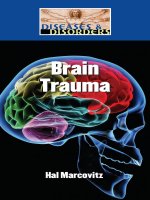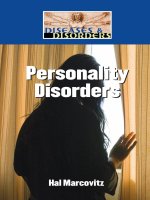Diseases and Disorders: Depression pot
Bạn đang xem bản rút gọn của tài liệu. Xem và tải ngay bản đầy đủ của tài liệu tại đây (4.29 MB, 105 trang )
Lizabeth Peak
Lizabeth Peak
Depression
Depression
Lydia Bjornlund
Lydia Bjornlund
Lydia D. Bjornlund
D epressi on
© 2010 Gale, Cengage Learning
ALL RIGHTS RESERVED. No part of this work covered by the copyright herein
may be reproduced, transmitted, stored, or used in any form or by any
means graphic, electronic, or mechanical, including but not limited to photo-
copying, recording, scanning, digitizing, taping, Web distribution, information
networks, or information storage and retrieval systems, except as permit-
ted under Section 107 or 108 of the 1976 United States Copyright Act, with-
out the prior written permission of the publisher.
Every effort has been made to trace the owners of copyrighted material.
Lucent Books
27500 Drake Rd.
Farmington Hills, MI 48331
ISBN-13: 978-1-4205-0217-6
ISBN-10: 1-4205-0217-4
LIBRARY OF CONGRESS CATALOGING-IN-PUBLICATION DATA
Printed in the United States of America
1 2 3 4 5 6 7 14 13 12 11 10
Bjornlund, Lydia D.
Depression / by Lydia Bjornlund.
p. cm. (Diseases & disorders)
Includes bibliographical references and index.
ISBN 978-1-4205-0217-6 (hardcover)
1. Depression, Mental Popular works. I. Title.
RC537.B515 2010
616.85'27 dc22
2009033487
Foreword 4
Introduction
Beyond Sadness 6
Chapter One
What Is Depression? 9
Chapter Two
Causes of Depression 29
Chapter Three
Treatment for Depression 43
Chapter Four
Living with Depression 62
Chapter Five
New Findings and Solutions 78
Notes 90
Glossary 93
Organizations to Contact 95
For Further Reading 98
Index 100
Picture Credits 104
About the Author 104
Table of Contents
4
foreword
“The Most
Difficult Puzzles
Ever Devised”
Charles Best, one of the pioneers in the search for a cure for
diabetes, once explained what it is about medical research that
intrigued him so. “It’s not just the gratification of knowing one
is helping people,” he confided, “although that probably is a
more heroic and selfless motivation. Those feelings may enter
in, but truly, what I find best is the feeling of going toe to toe
with nature, of trying to solve the most difficult puzzles ever
devised. The answers are there somewhere, those keys that
will solve the puzzle and make the patient well. But how will
those keys be found?”
Since the dawn of civilization, nothing has so puzzled people—
and often frightened them, as well—as the onset of illness in
a body or mind that had seemed healthy before. A seizure, the
inability of a heart to pump, the sudden deterioration of muscle
tone in a small child—being unable to reverse such conditions or
even to understand why they occur was unspeakably frustrating
to healers. Even before there were names for such conditions,
even before they were understood at all, each was a reminder of
how complex the human body was, and how vulnerable.
While our grappling with understanding diseases has been
frustrating at times, it has also provided some of humankind’s
most heroic accomplishments. Alexander Fleming’s accidental
discovery in 1928 of a mold that could be turned into penicillin
has resulted in the saving of untold millions of lives. The isola-
tion of the enzyme insulin has reversed what was once a death
sentence for anyone with diabetes. There have been great strides
in combating conditions for which there is not yet a cure, too.
Medicines can help AIDS patients live longer, diagnostic tools
such as mammography and ultrasounds can help doctors find
tumors while they are treatable, and laser surgery techniques
have made the most intricate, minute operations routine.
This “toe-to-toe” competition with diseases and disorders is
even more remarkable when seen in a historical continuum.
An astonishing amount of progress has been made in a very
short time. Just two hundred years ago, the existence of germs
as a cause of some diseases was unknown. In fact, it was less
than 150 years ago that a British surgeon named Joseph Lister
had difficulty persuading his fellow doctors that washing their
hands before delivering a baby might increase the chances of
a healthy delivery (especially if they had just attended to a
diseased patient)!
Each book in Lucent’s Diseases and Disorders series ex-
plores a disease or disorder and the knowledge that has been
accumulated (or discarded) by doctors through the years.
Each book also examines the tools used for pinpointing a di-
agnosis, as well as the various means that are used to treat or
cure a disease. Finally, new ideas are presented—techniques
or medicines that may be on the horizon.
Frustration and disappointment are still part of medicine,
for not every disease or condition can be cured or prevented.
But the limitations of knowledge are being pushed outward
constantly; the “most difficult puzzles ever devised” are finding
challengers every day.
Foreword 5
6
InTroduCTIon
Beyond Sadness
Everyone occasionally feels blue or sad, but these feelings
usually pass within a few hours. Even when dealing with grief
or a major sorrow, people typically begin to feel a bit better
in a few days. Those suffering from depression, on the other
hand, may not be able to identify a reason for their sadness. In
contrast to normal feelings of sadness, depression is a more
generalized and persistent feeling of gloom or despair that can
significantly interfere with a person’s thoughts, mood, behav-
ior, and physical health.
A depressive disorder interferes with daily life and causes
pain for both the person with the disorder and those who care
about him or her. One woman diagnosed with depression de-
scribes how it saps her energy:
The things with depression that bother me the most are
feeling like you’re encased in cement, where you just
can’t drag your body out of bed, where the simplest of
tasks is just daunting and you have to force yourself to
re-focus and to pick yourself up and to take that shower,
get to the grocery store, get the kids off to school, get to
the office, get through your day.
1
Depression is a common but serious illness that affects
more than 100 million people worldwide. According to the
National Institute of Mental Health (NIMH), about 19 million
Americans—9.5 percent of the population—suffer from de-
pression. Fortunately, the vast majority of people—even those
with severe depression—can get better with treatment.
Depression has always existed, but its causes have never
been fully understood. Many years ago, people believed that
mental illnesses, including depression—or melancholia, as it
was called then—were the result of an imbalance in bodily flu-
ids. People also once thought mental illness was a sign of the
devil. Throughout history, depression has also been viewed as
a lack of willpower, laziness, or simply a disagreeable nature.
Today, depression is viewed as having both situational and
physical causes. While most experts agree that depression is a
serious mental illness, many people worry that natural, and in
many cases, appropriate, feelings of sadness or grief may be
misdiagnosed as a “disease.” Depression is different from grief
or loneliness. When people are grieving, they mourn their
loss but retain a sense of self-esteem. Lonely people may be
Beyond Sadness 7
People suffering from depression experience persistent feelings of
melancholy and hopelessness.
8 Depression
sad, but they do not have an impending sense of dread that is
associated with depression.
Many patients who suffer from depression say they cannot
live without the drugs and therapy they receive as part of their
treatment plan. “Every morning I wake up and dread getting
out of bed,” says Bernard, an eighty-three-year-old who was
diagnosed with depression five years ago. “But after I have my
[antidepressant] pill, I always feel much better.”
2
Depression is a mental illness that affects millions of people
in countless ways. Some people are able to continue going
to school, to their jobs, to the many other activities that they
enjoy. But for many, depression is a debilitating disease that
stops them in their tracks. They find it difficult to get out of
bed or to take care of themselves, let alone their family. They
feel a sense of hopelessness. The good news is that depression
can be treated. Even for the most severe cases of depression,
proper diagnosis and treatment can lead to long, healthy, and
productive lives.
9
ChapTer one
What Is Depression?
At times, we all feel sad in response to a loss, disappoint-
ment, or frustration. This is normal. Many people who are sad
say they are “depressed,” but sadness in response to a specific
situation is normal. Clinical depression is vastly different from
these temporary states. Unlike normal feelings of sadness, de-
pression overwhelms a person, lasts a long time, and interferes
with his or her day-to-day life.
Some people describe depression as a black hole or a cur-
tain coming down over their life. People suffering from depres-
sion often see no hope. They may have a constant feeling of
impending doom. In fact, some people with depression do not
feel sad as much as lifeless or empty. They may be unable to
experience any emotions at all.
How Serious Is Depression?
A recent study sponsored by the World Health Organiza-
tion and the World Bank found major depression to be the
fourth leading cause of disability worldwide, and it is antici-
pated to become the second most disabling disease by 2020
(surpassed only by heart disease). The National Alliance on
Mental Illness says that major depression is the leading cause
of disability in the United States and many other developed
countries.
One reason for the level of disability is the sheer duration of
depressive episodes. A major study of patients who required
hospitalization for depression found that the median time to
10 Depression
recover was five months. In other words, half of the people
hospitalized for depression recovered in five months or less;
the other half needed longer than five months. Another prob-
lem is that many people have recurring incidences of depres-
sion or continue to experience some residual symptoms of
depression even after they are feeling better.
Depression is classified as a mood disorder, a term used for
any disorder in which a disturbance in the person’s mood is the
main feature or problem. One of the most common and most
serious types of depression is major depression, which is also
called major depressive disorder or clinical depression. Other
types of depression include dysthymia, seasonal affective dis-
Symptoms of Depression
Symptoms vary from one person to another and may change
over time. The symptoms typically associated with depression
include:
• persistent feelings of sadness or anxiety
• irritability or restlessness
• decreased interest or pleasure in hobbies and activities
(called anhedonia)
• loss of energy; tiredness
• overeating or loss of appetite
• weight loss or weight gain
• insomnia, difficulty sleeping, early morning awakening, or
sleeping too much
• inability to concentrate; memory loss
• indecisiveness
• pessimism
• feelings of worthlessness, hopelessness, or guilt
• persistent aches or pains, cramps, or digestive problems that
do not ease with treatment
• thoughts of suicide or death
What Is Depression? 11
order, and postpartum depression. These types of depression
vary greatly in onset and severity.
Major Depression
Major depression, the most severe type of depression, affects
roughly 14.8 million American adults—or 5 to 8 percent of the
population—in any given year. People young and old suffer
from clinical depression; the median age for onset is thirty-two
years. People who have gone through an episode of depression
are at risk of having another episode at one point or another.
Some people experience recurring episodes of major depres-
sion throughout their lives.
Major depression prevents a person from functioning
normally. It is characterized by a combination of symptoms
that interfere with a person’s ability to work, study, sleep,
and eat. The signs and symptoms vary from one person to
another. Many depressed people complain that they have no
energy. They may be constantly anxious or irritable. Con-
centration and memory problems are common, making tasks
more difficult. People may not have energy to do much of
anything; activities that were once fun are no longer enjoy-
able. Some people have difficulty sleeping or staying asleep;
others sleep all the time. Some individuals lose their appe-
tite, while others eat constantly to fill the void they feel in
their lives. Often, people with major depression have little
sense of self-worth and an overwhelming sense of dread or
hopelessness.
Some people struggle with major depressive episodes all
their lives. Singer Sheryl Crow, for instance, has said that she
has experienced chronic depression since she was a child.
During one six-month period in the late 1980s, there were days
when Crow’s depression made it impossible for her to leave
the house: “During some of those darkest days, I’d hardly get
out of bed and just let the phone ring and ring. Small problems
became insurmountable.” Still, like many of those who suffer
from major depression, Crow was helped through antidepres-
sants and psychotherapy. “For some reason, surrounded by
my friends on my [fortieth] birthday, it was like there was a
sudden break in the clouds. Depression goes away as suddenly
as it descends.”
3
Dysthymia
Dysthymia, also called dysthymic disorder, is a relatively com-
mon form of depression. The word dysthymia comes from the
Greek term meaning “ill humor or bad mood.” Dysthymia is a
chronic form of depression that affects 5 to 6 percent of the
U.S. population.
The symptoms of dysthymia are less severe than in episodes
of major depressive disorder. Life is gray and uninteresting.
Famed singer Sheryl Crow, who has struggled with depression
throughout her life, has learned to cope with the illness.
What Is Depression? 13
People with dysthymia feel mildly depressed on most days
over a period of at least two years. Studies show that dysthy-
mia usually has a gradual onset, often in people in their late
teens or early twenties with a family history of depression.
People who are socially isolated or who lack strong support
groups are particularly vulnerable.
Although its symptoms are less debilitating, dysthymia is
a serious form of depression. It rarely goes away without be-
ing treated with drugs or psychotherapy or a combination of
both. Dysthymia can occur alone or with more severe depres-
sion. In one study, 76 percent of people with dysthymia had a
major depressive episode within five years of diagnosis.
In Depression and Bipolar Disorder psychiatrist Virginia
Edwards describes Martin, a hardworking executive who
suffers from dysthymia. Martin is somewhat difficult to get
along with at work, but he is a valued employee because he
runs the office efficiently. Like many people with dysthymia,
Martin rarely goes out socially. He tends to find fault with his
friends and the women to whom he is introduced. “Martin
can’t remember a time when he felt relaxed and happy,” Ed-
wards writes. “He is always anticipating trouble and worried
about the future. He thinks other people must feel the same
way but manage to hide it better.”
4
Seasonal Affective Disorder
Several other depression-related mood disorders are trig-
gered by specific aspects of a person’s environment.
Seasonal affective disorder (SAD), for instance, is charac-
terized by the depressive episodes that occur only during
the winter months, when there is less sunlight. Differences
in mood are common ailments: People often talk of the
“winter blues” or “cabin fever” they get when cooped up
all winter. SAD is typically diagnosed when these mood
changes are severe and when they occur over two or more
seasons. Although SAD is usually considered a “winter”
disease, a rarer form of the disorder affects people during
the summer months.
14 Depression
Fantasy writer Barbara Hambly says she first noticed symp-
toms of depression when she took a trip to Australia at the age
of fifteen. “My memories of Australia are a bit ambiguous, be-
cause I suffer from seasonal affective disorder: depression in
the winter as the hours of sunlight shorten,” Hambly writes. “It
took me until I was nearly fifty to figure it out, but the equato-
rial swap from midsummer to midwinter causes a dislocation
in my brain-chemistry whose effect is to throw me into severe
depression—exacerbated by whatever else is going on in my
life or in the world at the time.”
5
SAD has been linked to a biochemical imbalance in the brain
prompted by less daylight. Sufferers experience many of the
Seasonal affective disorder (SAD) is a depressed state occurring
only during the dreary winter months.
What Is Depression? 15
same symptoms as with major depression, but the SAD patient
almost always has an increase in sleep, complaining of chronic
fatigue throughout the winter months. In addition, an increase
in appetite rather than a decrease is more common; SAD pa-
tients may gain weight each winter. Many SAD sufferers report
food cravings, particularly for sweets and carbohydrates. With
SAD, these symptoms go away during the spring and summer
months. Approximately 500,000 American adults seek treat-
ment for SAD each year. The incidence appears to be higher
among women than men.
Postpartum Depression
Another common situational type of depression is postpartum
depression. This term is used to describe a major depressive
episode experienced by a mother after having a baby. Post-
partum depression usually occurs in the first few weeks, but
for some women the onset may come several months after
delivery. In addition to changes in hormone levels, experts cite
sleep deprivation, increased stress that comes from having to
care for a baby, and a loss of the sense of self and control over
one’s self as contributing factors to postpartum depression.
In Down Came the Rain, actress Brook Shields describes
her depression following the birth of her baby: “I was in a
bizarre state of mind, experiencing feelings that ranged from
embarrassment to stoicism to melancholy to shock, practi-
cally at once. I didn’t feel at all joyful.”
6
Shields assumed she
would bounce back when she had gotten enough rest from her
difficult labor, but her feelings intensified: “During what was
becoming one of the darkest points in my life, I sat holding my
newborn and could not avoid the image of her flying through
the air and hitting the wall in front of me.”
7
Shields worried that
the feelings showed no signs of letting up. “This felt like my life
was over and I would never be happy again.”
8
Postpartum depression is estimated to affect 10 to 15 per-
cent of new mothers. Women who experience postpartum
depression after one birth are more likely to have a recurring
episode after subsequent births. The symptoms are the same
as with any major depressive episode, but postpartum depres-
sion can interfere with the mother’s ability to care for and
bond with her newborn.
Psychotic Depression
In some cases, depression becomes so severe that the sufferers
develop delusions or hallucinations. They might think they are
already dead or that they are responsible for war, hunger, or
natural disaster. They might hear voices saying they are worth-
less or urging suicide or other destructive behavior. When
people become out of touch with reality, they are said to be
suffering from psychotic depression. In Psychotic Depression,
Conrad Schwartz and Edward Shorter describe a woman diag-
nosed with psychotic depression:
[She had been] talking to the television, stating delusions
that her husband is a famous religious icon, threatening
him, and battering him. She was unkempt, quiet, and
emotionally flat, and she moved little. She spoke slowly,
answered “I don’t know” to most questions, and reported
hearing the voice of a holy man and seeing people who
were not there.
9
After childbirth some women experience postpartum depression,
which may interfere with a new mother’s ability to care for her
newborn.
What Is Depression? 17
Psychotic depression is more common among elderly peo-
ple. It tends to strike less healthy people who have a history of
psychosis and depression in their family. Relatively rare, this
is a serious form of depression because people may give in to
the voices that haunt them. Images of brains of patients with
this form of depression suggest that the disease may be due
to a brain abnormality. Most people suffering from psychotic
depression do not recover without treatment.
Depression and Bipolar Disorder
Major depression, dysthymia, SAD, and psychotic depression
are all characterized by intense lows. These forms of depres-
sion are sometimes called unipolar depression to differentiate
them from bipolar disorder, a mood disorder in which the lows
are interspersed with highs. Sometimes people can swing rap-
idly between moods, but usually the change from one mood to
another is fairly gradual. One sufferer describes the symptoms:
If you have bipolar [disorder] as I do, . . . you wear many
faces. You are either the life of the party and feel that life
is wonderful and so much fun, only to wake up the next
day so depressed you think you won’t make it until the
next day. Then within a few hours or 6 months, you are
screaming at the top of your voice, feeling extremely out
of control, extremely irritable and you want to smash ev-
erybody and everything around you.
10
Roughly 5.5 million American adults have been diagnosed
with bipolar disorder. Bipolar disorder differs from other
forms of depression in both causes and treatments. Unlike
unipolar depression, bipolar disorder almost always requires
medical treatment for life.
Who Gets Depression?
Depression affects people from all walks of life. Many well-
known people have suffered from major depression. It was
once believed to be the curse of creative genius. Authors Hans
18 Depression
Christian Andersen, Ernest Hemingway, and J.K. Rowling are
among the many authors who described their major depressive
episodes. Dutch painter Vincent van Gogh also suffered from
depression, probably from childhood. His sister said that as a
child, Vincent was “intensely serious and uncommunicative, and
walked around clumsily and in a daze, with his head hung low.”
11
He himself later described his childhood as “gloomy and cold
and sterile.”
12
Abraham Lincoln also is believed to have been a
lifelong sufferer of depression; major depressive episodes were
exacerbated by the death of his son and the stress of the Civil
War. British prime minister Winston Churchill also suffered
from the disease, which he called his “black dog.”
Lincoln and Churchill were in good company. A 2006 study
by Duke University suggests that 24 percent of U.S. presidents
suffered from depression. According to the study, at least ten
Nineteenth-century president Abraham Lincoln suffered from
depression—intensified by his son’s death and by the stress of
the Civil War, which occurred during his presidency.
What Is Depression? 19
Famous People with Depression
Many famous people have been diagnosed with depression. J.K.
Rowling recently discussed her depression and admitted that
her despair was once so great she attempted suicide. Author Ann
Rice also has discussed the depression she has suffered following
the death of her husband. Like many others, Ernest Hemingway
dealt with his depression through alcohol; Hemingway’s grand-
daughter Margaux, who became a famous actress, also suffered
from severe depression—just one of the family connections that
suggest a genetic factor. Contemporary musicians who have
been diagnosed with depression include Janet Jackson, Elton
John, Beyoncé Knowles, and Kurt Cobain, the lead singer of the
highly successful band Nirvana, who committed suicide in 1994.
Actors who have had major depressive episodes include Drew
Barrymore, Kirsten Dunst, Gwyneth Paltrow, and Heath Ledger,
who died of an overdose of prescription medications at the top
of his career in 2008.
Depression does not strike only artistic temperaments.
American astronaut Buzz Aldrin suffered from depression,
as did Abraham Lincoln and Winston Churchill. In a 1995 in-
terview Princess Diana revealed that she had suffered from
postpartum depression after her first son, Prince William, was
born. Singer Marie Osmond and actor Brooke Shields also have
discussed their fight with postpartum depression following
the birth of babies.
Of course, most people who suffer from depression are not
famous. In fact, many cannot even hold down a job. Success
can be difficult to achieve when even the simplest task seems
like an immense hurdle. Many people with depression are suc-
cessful in their fields only because they have succeeded first in
obtaining an accurate diagnosis of and appropriate treatment
for their illness.
20 Depression
presidents suffered from depressive episodes while in office.
In almost all cases, the depressive symptoms interfered with
their performance. Experts speculate that the stress of leading
a nation may make national politicians particularly susceptible
to depression.
Women and Depression
Women and men can both become depressed, but women are
almost twice as likely to be diagnosed with depression. Experts
believe women may be at higher risk due partly to hormonal
changes brought on by puberty, menstruation, menopause, and
pregnancy. Researchers have shown that hormones directly af-
fect the parts of the brain that control mood. Many new moth-
ers experience a brief episode of the “baby blues” immediately
after giving birth; experts suggest that the depression that is
sometimes diagnosed in new mothers—called postpartum
depression—results from the same physical and emotional
stresses as those causing more “normal” feelings. Studies also
show that women who experience postpartum depression of-
ten have had prior depressive episodes and are more likely to
experience major depression later in life.
Research suggests that hormonal changes may also account
for depressive episodes during other times in a woman’s life.
The risk of depression increases with menopause, for instance.
Scientists believe that the rise and fall of estrogen and other
hormones may affect the brain chemistry that is associated
with depressive illness.
Societal and environmental factors may also play a role.
The stress of balancing work and home responsibilities, car-
ing for young children and/or aging parents, abuse, poverty,
and dealing with difficult relationships may all increase the
risk of depression.
Men and Depression
The risk for depression is lower for men than for women, but
men are by no means immune to the disorder. More than 6 mil-
lion American men are treated for depression each year. Some
What Is Depression? 21
experts suggest that the number of men with depression may
actually be much higher because many men do not seek help.
Although depression and other mental illnesses do not have
the stigma they once did, many men still believe that asking for
help for emotional problems is a sign of weakness.
Men also react to depressive feelings differently than wo-
men. Men are more likely to become hostile or violent. Oth-
ers may turn to drugs or alcohol to deal with their feelings of
despair or hopelessness. They may throw themselves into their
work to avoid having to focus on their feelings, or engage in
risky recreational pursuits, extreme sports, or reckless behav-
ior. Suicide is an especially serious risk for men with depres-
sion. Although more women attempt suicide, men are four
times more likely than women to succeed.
Depression in the Elderly
Depression among the elderly is sometimes difficult to diag-
nose. Seniors often have different, less obvious symptoms.
They also may be less inclined to acknowledge feelings of sad-
ness, and when they do, others may assume these feelings are
normal for older people. As people age, they are more likely
to experience the loss of loved ones. They may suddenly have
to adjust to living alone after decades of living with a spouse
or other family members. Older people also may suffer from
pain. Even minor disabilities or illnesses, such as arthritis or
diabetes, can interfere with the ability of a senior to enjoy life
to the fullest. In addition, depression can be a side effect of
some medications taken to treat such diseases.
Aging can be a stressful and anxious experience. Having to
adjust to major life changes such as retirement or the transi-
tion into an assisted living community or a nursing home can
contribute to the risk of depression. Retirees may no longer feel
needed. Seniors may worry about getting sick or losing their
mobility and their independence. Depression is often a second-
ary concern for those suffering from a chronic illness such as
heart disease or cancer. Even healthy elderly people with de-
pression may dwell on morbidity and have a fear of dying.
The changes people go through as they age can all contrib-
ute to depression, but it is important to note that depression is
not a normal or necessary aspect of aging. In fact, studies show
that most seniors are satisfied with their lives.
Depression can be hard to diagnose in elderly patients.
Elderly people are more likely than younger adults to have a
depressive illness that goes undetected and thus untreated,
which may contribute to the high risk of suicide among older
patients. Many people assume that the highest rates of suicide
are among young people, but suicide is a problem among the
elderly. Americans aged sixty-five and older account for about
13 percent of the population but almost 20 percent of all sui-
Elderly people may face a host of situations that can cause
depression, such as the death of a spouse, chronic illness, and
loneliness.
What Is Depression? 23
cides. The suicide rate of this population (eleven suicides for
every hundred thousand people) is higher than for any other
age group, and the attempts are serious: One out of four suc-
ceeds, compared with one out of two hundred for young adults.
Depression in Children and Teens
Until recently, many doctors and other professionals did not be-
lieve that children could be depressed. Recent research shows
that children can suffer from many of the same depressive dis-
orders as adults. Although the onset of depression is typically
between the ages of twenty and forty, recent research shows
that the average age of onset is decreasing with each generation.
Today, about 2.5 million people under the age of eighteen in the
United States are diagnosed with major depression. As teenag-
ers get older, their risk of experiencing depression increases.
According to the U.S. Department of Health and Human Ser-
vices, 5.4 percent of twelve- to thirteen-year-olds are depressed,
but 12.3 percent of sixteen- to seventeen-year-olds suffer from
depression.
Unfortunately, depression in young people often goes undi-
agnosed. Parents often assume that signs of illness are “just a
phase.” As a result, fewer than half of children and teens with
depression receive treatment. Left untreated, childhood depres-
sion often continues into adulthood. Many people who have
minor depression as children will experience more severe ill-
nesses in adulthood.
As children, boys and girls are equally likely to develop de-
pressive disorders. By age fifteen, however, girls are twice as
likely as boys to have had a major depressive episode. Some
experts believe the higher rate among adolescent girls may be
due to both biology and environmental factors. Changes in the
levels of female hormones during puberty may be to blame.
In addition, the fact that girls are more socially oriented than
boys may make girls more vulnerable to feelings of loss and
despair following a breakup with a close friend.
Adolescence brings on a great many physical and emotional
changes. Breaking away from one’s parents, making decisions
24 Depression
on one’s own, grappling with issues related to dating, dealing
with peer pressure, deciding where to go to college or what to
do with one’s future—these are just a few of the stresses faced
by today’s teens. Many experts believe these new stresses con-
tribute to the risk of clinical depression for both boys and girls.
According to the Center for Mental Health Services, about
one in every ten teens in the United States suffers from some
type of depression. Depression among teens frequently coin-
cides with anxiety, eating disorders, or substance abuse. It also
increases the risk of teen suicide.
Health Risks
Depression can have a major impact on sufferers’ health.
People with depression are at greater risk of developing other
physical illnesses. Experts caution that those suffering from
depression may be less likely to go to the doctor when they are
sick and/or to heed the doctor’s advice. Research also suggests
that depression and the resulting stress weakens the immune
system and reduces its ability to fight infection. Studies show
that vaccinations are less effective in people with depression,
leaving them more vulnerable to illness.
Recent studies have also shown that people with depres-
sion who are recovering from strokes or heart attacks have
more difficulty making health care choices, following a doc-
tor’s instructions, and coping with the challenges that such
illnesses present. Studies also have linked depression to
heart disease. One study found that patients with depression
also have a higher risk of death in the first few months after
a heart attack.
The more severe the symptoms of depression, the greater
the impact on a person’s day-to-day life. People suffering from
a mild form of the illness might be able to continue their usual
activities, although they might not find them quite as enjoy-
able. As depression takes hold, however, it might take more
and more effort to get up in the morning, leave the house, and
concentrate at school or work. In severe cases of depression,
any activity beyond simply surviving can become difficult.









